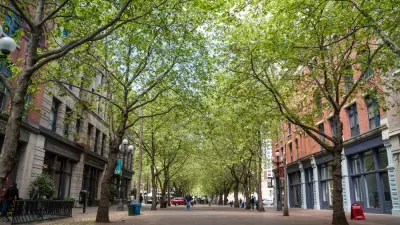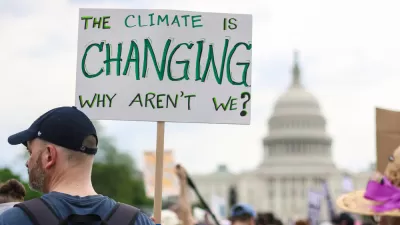To meet the U.N.’s global warming targets, city leadership is critical.
The international agreement struck in Paris last week has been hailed as an historic grand bargain that charts an ambitious course to limit global warming through reductions of greenhouse gas emissions, reforestation, and financial incentives for sustainable development.
"But while the agreement commits its 196 signatories to cut emissions and report progress on a national level, at least one-third of the carbon budget remaining to stay under 2 degrees Celsius is in the control of cities and local governments, and everyone at COP21 seemed to know it," writes Feargus O'Sullivan.
World Bank representative Rachel Kyte emphasized the importance of cities to the implementation of the agreement.
“Please understand that the fundamental financial health of cities will be absolutely fundamental to reaching Paris’ goals.”
Coalition-building at the city level has been going on for some time. Leaders from 436 cities around the world have committed to the Compact of Mayors, a coalition that represents 377 million people. Many urban leaders recognize that if sea levels rise as much as currently predicted, the land submerged in the sea would displace millions of their own constituents. According to O'Sullivan, city governments are working together "to compare practices, pool expertise and resources and make collective commitments that don’t necessarily require national rubber-stamping and can lead to tangible impacts."
O'Sullivan offers examples of local challenges in vulnerable urban regions. In Twshane, South Africa, an urban region that includes the city of Pretoria, harsh conditions in the natural environment combine with apartheid-era planning to create a complicated set of social, economic, and logistical problems that must be addressed in any effort to improve sustainability. "When unsustainable urban sprawl represents not just past planning choices but a firmly entrenched social hierarchy, the barriers to climate action are only likely to be greater," O'Sullivan writes.
In Melbourne, Australia, the city's efforts reduce emissions and the local climate conflicted with the national government's desire to sell dirty coal to China. So Melbourne built its own local market for renewable energy by collaborating with the local private sector.
"In many ways, Melbourne’s experience represents a coming-of-age of the urban sustainability movement," writes O’Sullivan. "The private sector is listening to cities and responding. Now it’s up to cities and national governments to continue the conversations that began at COP21 and continue the evolution."
FULL STORY: The Urban Planner’s Guide to a Post-COP21 World

Alabama: Trump Terminates Settlements for Black Communities Harmed By Raw Sewage
Trump deemed the landmark civil rights agreement “illegal DEI and environmental justice policy.”

Planetizen Federal Action Tracker
A weekly monitor of how Trump’s orders and actions are impacting planners and planning in America.

The 120 Year Old Tiny Home Villages That Sheltered San Francisco’s Earthquake Refugees
More than a century ago, San Francisco mobilized to house thousands of residents displaced by the 1906 earthquake. Could their strategy offer a model for the present?

Opinion: California’s SB 79 Would Improve Housing Affordability and Transit Access
A proposed bill would legalize transit-oriented development statewide.

Record Temperatures Prompt Push for Environmental Justice Bills
Nevada legislators are proposing laws that would mandate heat mitigation measures to protect residents from the impacts of extreme heat.

Downtown Pittsburgh Set to Gain 1,300 New Housing Units
Pittsburgh’s office buildings, many of which date back to the early 20th century, are prime candidates for conversion to housing.
Urban Design for Planners 1: Software Tools
This six-course series explores essential urban design concepts using open source software and equips planners with the tools they need to participate fully in the urban design process.
Planning for Universal Design
Learn the tools for implementing Universal Design in planning regulations.
Clanton & Associates, Inc.
Jessamine County Fiscal Court
Institute for Housing and Urban Development Studies (IHS)
City of Grandview
Harvard GSD Executive Education
Toledo-Lucas County Plan Commissions
Salt Lake City
NYU Wagner Graduate School of Public Service





























